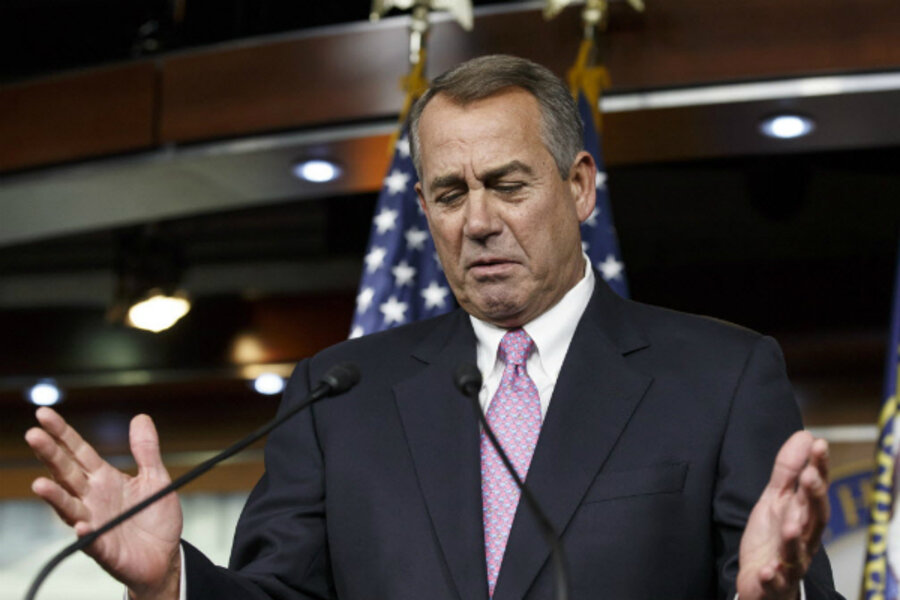House Republicans near a deal to raise the debt ceiling
Loading...
| Washington
As the US debt limit extension expired Friday – signaling that the nation can no longer borrow money to pay its bills – a plan to raise the debt limit and avoid default started to take shape.
House Republicans are moving toward legislation that would raise the debt ceiling through the first quarter of next year and, at the same time, restore recent cuts in some veterans’ retirement benefits and patch a Medicare reimbursement rate for nine months, according to Politico.
Time is of the essence. In a letter to the congressional leadership on Friday, Treasury Secretary Jacob Lew said that measures to fund the government won’t last beyond Feb. 27. Moreover, Secretary Lew has fewer bookkeeping tricks to prolong the deadline than was the case during previous bids to raise the debt ceiling. The onset of the tax filing season complicates his ability to forestall default.
House Speaker John Boehner (R) of Ohio promised on Thursday that the GOP-led House will indeed raise the debt cap. “We’re not going to default on our debt,” he stated. He even noted the possibility of a vote on a “clean” bill, free of any GOP conditions.
The reported package – which increases spending on two programs, albeit with offsetting cuts – would be in stark contrast to 2011, when the House exacted more than $2.4 trillion in spending cuts over 10 years, including $1 trillion in automatic, across-the-board budget cuts – known as the “sequester.”
In 2011, the House was riding the crest of the tea party wave, which pounded Washington with demands to end excessive spending and borrowing. That May, when the national debt was about $14 trillion, Mr. Boehner gave a forceful speech at the Economic Club of New York, demanding budget cuts that “should be greater than the accompanying increase in debt authority that the president is given.”
But the political climate in February 2014 is considerably cooler than the hothouse of August 2011, when a united GOP caucus took the nation right up to the edge of default before a debt deal, called the Budget Control Act, was signed.
This time around, Boehner has struggled to find agreement in his own caucus on a package of conditions, and they are hardly of the trillion-dollar variety. The debt is higher now, at more than $17 trillion, but the nation is weary and cautious of the hardball GOP tactics that brought on the partial government shutdown of last October.
So are some conservative Republicans. "I do not want to get into a cataclysmic fight," says Rep. Raul Labrador (R) of Idaho.
Congress also faces midterm elections, which was not the case in 2011.
The types of debt ceiling plans that the speaker has been considering also show how times have changed. In general, they are smaller bore and seem more designed to score political points than advance much – if any – structural change to the budget or federal programs.
This week, Boehner discarded suggestions to attach to debt limit legislation a requirement that the administration sign the Keystone XL pipeline deal or get rid of insurance “risk corridors” under Obamacare.
What’s reportedly taking shape now are measures to restore a trim to pensions for veterans under 62 (last year's budget agreement called for $6 billion in cuts) and to avoid mandated double-digit cuts in reimbursements for doctors serving Medicare patients, called the "doc fix." These spending increases would be offset by cuts to mandatory spending and changes to pension contributions, Politico reports.
But as Boehner acknowledged this week, it will be tough to find 218 Republican votes to pass a package of conditions attached to a debt ceiling increase. On Thursday he quipped: “Mother Teresa is a saint now, but you know, if the Congress wanted to make her a saint and attach that to the debt ceiling, we probably couldn’t get 218 Republican votes.”
The Democrats are sure not saints in the eyes of Republicans, but in the end, they might save the day – and the financial markets – by helping the speaker pass a bill free of conditions that many in his conference will refuse to support.








